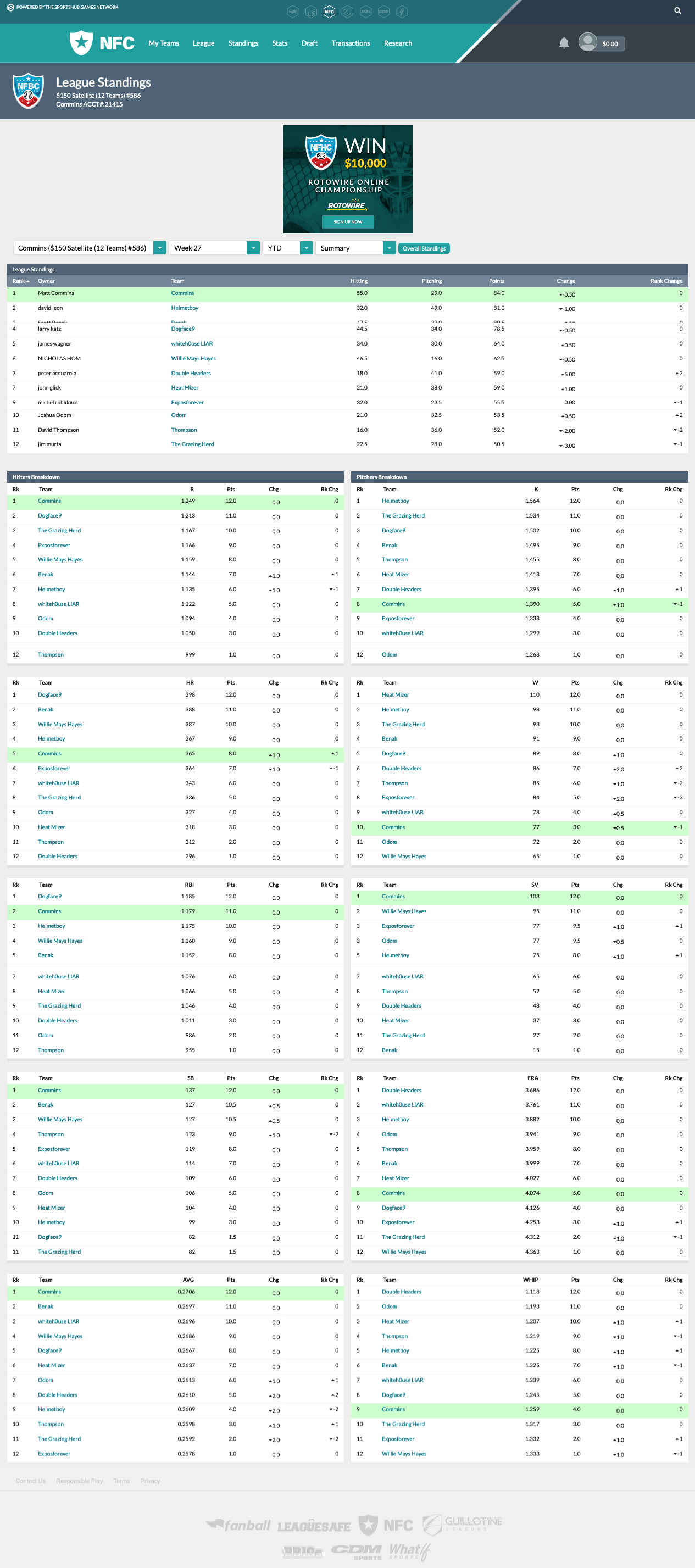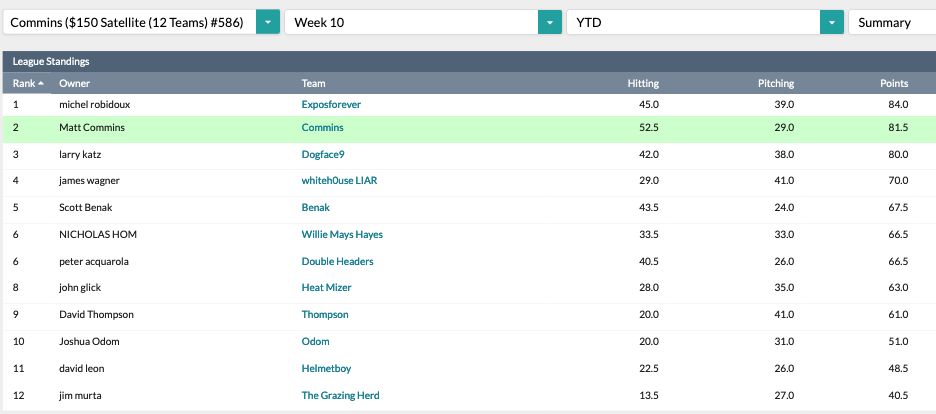Yesterday (September 29) was the last day of the regular season, which means it was the end of the fantasy baseball season. Every year I write a recap of each of my leagues. This process is masterbatory because the only one who gets any benefit and/or knowledge from this is me.
I have great news. I won this league! To see my recap after the draft and the players I drafted please go here. I will assume you have this knowledge when I provide my analysis.
After the draft I projected the following Hitting Statistics:
Forecast: .268 Avg/ 327 HRs/ 1,163 RBI/ 1,150 Runs/ 156 SBs
Actual: .271 Avg/ 365 HRs/ 1,179 RBI/ 1,249 Runs/ 137 SBs
Pitching Stats:
Forecast: 3.61 ERA/1.22 WHIP/ 1,360 Ks/ 86 W/ 109 Saves
Actual: 4.07 ERA/ 1.26 WHIP/ 1,390 Ks/ 77 W/ 103 Saves
 Overall Takeaways From 2019 & 2020
Overall Takeaways From 2019 & 2020
Reliable stolen bases and saves are going to be extremely scare and important in 2020. I was listening to the 2019 recap of The Fantasy Focus and Tristan H. Cockcroft said saves in 2019 were 25% more important than previous years. I haven’t done my own analysis yet, but that number feels right. Saves were down this year and half of the teams finished the year with less than a .500 record.
(A quick aside: Teams were bad for many reasons, but there are two primary reasons for this. 1) Teams are rewarded for losing. Draft pick compensation pools are larger for worser teams. So if a team has the worst record they’re allowed to spend more in next year’s draft. 2) Teams have learned they don’t have to invest on the Major League roster to make money. Joe Sheehan has written about this for years. The cliff notes is he consistently rags on the owners of the Pirates, Royals and Jeffrey Loria, the previous owner of the Marlins for consistently putting profits ahead of win. That they are pocketing their TV money and making a profit, even when their teams are good and they have an opportunity to make a playoff push.)
Back to saves. Next year it’s going to be important to draft a reliable closer. You’re going to want someone who will be the closer as long as he’s healthy such as: Kirby Yates, Aroldis Chapman, Kenley Jansen, Roberto Osuna and etc. If you don’t draft a reliable closer you may have to punt the category and I’m not a big fan of punting.
From 2013-2018 the league averaged 2,583 stolen bases. This year we only had 2,281–the last time it was that low was 1973 (I didn’t count the strike years of 1981 and 1994). The guys who provide 30 stolen bases with 10 home runs will be worth much more than in years past.
The interesting dilemma fantasy owners will have is whether you want to consolidate the majority of your stolen bases in one player. For example, it’s going to be fascinating what people do with Adalberto Mondesí. If he plays in 150 games you’ll have about 50% of your stolen bases locked up, but if he gets hurt he may sink your ability to compete in the stolen base category.
I can see stolen bases decreasing even further. A lot of the top base stealers: Starling Marte, Elvis Andrus, Tommy Pham will all be 31 and 32 years old in 2020. And who knows if Christian Yelich will continue to steal bases after hurting his knee a week before the season ended. My hunch is Ronald Acuna will be the number one pick in Roto leagues with Trea Turner being a top 12 pick.
Home runs. Entering the season I thought we would see about the same numbers of home runs we saw in 2016. It wouldn’t be as much as 2017, but there would still be a lot of home runs. Well, shit. The powers that be decided to change the baseball and we saw the most home runs ever. As of right now, I have no idea if the baseball will change in 2020, but I’m going to assume the League hits 6,400 home runs next year, which is an average of 2017, the most home runs ever at the time, and 2019. The takeaway is home runs will far less valuable than any other time before. A 30 home run player in 2012 has the same value as a 40 home run player in 2020. Players like Mallex Smith, Joey Gallo and Rougned Odor all become less valuable next year. (I don’t believe Gallo is a .250 hitter).
Takeaways From My Season
I won my league so I’m obviously pleased with the outcome. I didn’t think my three closer strategy would work, but I picked Mike Minor early in the season and he was a defacto ace for most of the season. I also picked up Frankie Montas, but the rest of my bulk innings came from starters with ERAs in the low 4’s (Rick Procello, Chris Bassit, Anthony DeSclafani, Zach Eflin and Griffin Canning). I did as well as I did because my closers enabled me to finish first in saves, which allow the other pitching categories to under perform.
I didn’t have that many injuries to my offense. I lagged in home runs because I suffered injuries to Aaron Judge and Gregory Polanco. I only had seven guys give more than 500 at-bats–all of which over performed their ADPs (Bregman, Andrus, Grandal, Merrifield, Devers, Rosario and Starling Marte). What’s funny is some of them did things I didn’t expect from them. For example Andrus stole 31 bases while Merrifield only stole 20. At the beginning of the season I thought the stolen base totals would be reversed. That’s why luck will always be the invisible hand in fantasy baseball.
Overall, draft extra depth at offense. When I first started playing at NFBC I would load up my bench with high-risk, high-upside pitching. This strategy quickly didn’t work because if I suffered an injury to my offense the pool of replacements was low.
In draft, if you two players are equal, take the player with multiple eligibility. During the course of a long season the position flexibility allows to broaden your search on the waiver wire for hitters.
You win leagues by finding undervalued players in draft and the waiver wire. I drafted Devers in the 10th round; Christian Vazquez off waivers; Mike Minor off waivers; Frankie Montas off waivers; Andrus in the 14th round; Miguel Sano off waviers.
Also, it’s just as important to not swing and miss in the early rounds. For example, Merrifield in the 3rd; Marte in the 4th; Eddie Rosario in the 6th; Liam Hendricks (as my handcuff to Blake Treinen); Yasmani Grandal in the 9th.
Most importantly, it’s a fine line between being patient and knowing when to change your evaluation on a player. For example: Devers’ first month of the season was brutal. He didn’t have any home runs and was batting 7th in the lineup. I looked at his hard contact rates and I strongly believed he was getting unlucky.
Another example is Wellington Castillo. He started off slowly, but his underlying numbers were not very good and he was no long being used as the primary catcher. After one month I dropped him and picked up Vazquez, who ended up finishing second on ESPNs Player Rater for catchers (luck on my part).
Drafts will not be perfect. If you look at my draft you’ll see a lot of players who under performed, but most of those picks in the middle rounds. That indicates that even if you swing and miss, it’s okay to do so in the middle rounds. I used to believe drafting was 70% of the reason for success, but now I firmly believe its 45% draft, 40% roster management and 15% luck.




